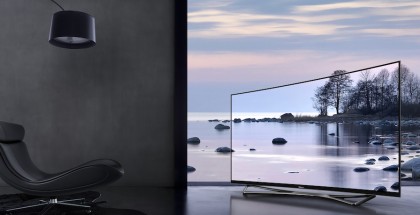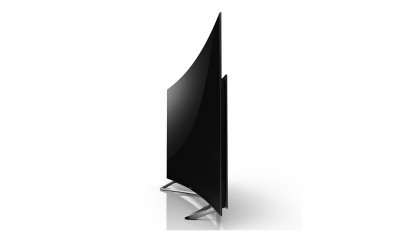Why you can trust TechRadar
So to the moment of truth: has the application of Panasonic's processing and, perhaps, experience with plasma technology to an OLED screen delivered the ground-breaking results I was hoping for?
Actually, yes.
The impact of 4K Pro is most visible during dark scenes. Such content generally looks nothing short of amazing on any OLED TVs, of course, thanks to the technology's self-emissive nature. But Panasonic's Absolute Black Drive means you can now enjoy OLED's amazingly rich, deep black levels without having to worry about the slight light inconsistency issues noted on LG's OLED TVs to date.
These issues, if you haven't yet read our recent review of the 65EF950V, are that the picture can darken at its left and right edges, and that those inky black colours can suddenly fall away dramatically at times, especially if you are trying to run the screen quite brightly.
With the 65CZ952, though, these issues seem to have been almost completely addressed, meaning that you can gawp at its extraordinary, OLED inspired black level depths without having to worry about them suddenly losing their way.
Amazing contrast
The thing about OLED, though, is not just that it can deliver deeper, more convincing black levels than any other TV technology to date. It's also capable of delivering these black levels without having to compromise the brightness and colour intensity of neighbouring bright picture elements.
Shots of outer space in Interstellar are a particularly good demonstration of just how good OLED's contrast performance is, as each tiny star in the sky and each bright reflection off the space craft's hull shines forth from the surrounding blackness with a revelatory level of intensity compared with the much flatter, more compromised look you get with even the best LCD TVs.
Sign up for breaking news, reviews, opinion, top tech deals, and more.
This makes dark scenes look much more dynamic and realistic, as well as helping them enjoy both the same level of intensity and same sense of depth and scale that bright scenes do. Such consistency between bright and dark scenes is crucial to a truly satisfying viewing experience, and no TV does it better than the 65CZ952.
As well as fixing the dark scene issues seen on LG's OLED TVs, the 65CZ952 suffers none of the backlight clouding or unevenness during dark scenes you get to some extent with even the best LCD TVs - which again makes it much easier to become totally lost in the movie worlds you're watching.

The little things matter
Panasonic's remarkably accurate control over OLED's self-emissive light properties helps the 65CZ952 produce gorgeous amounts of subtle shadow detail and colour gradation in dark areas too. There are some LCD screens this year that have also gotten amazingly good at this (including Panasonic's own CX802 TVs), but for me the 65CZ952 still sets a new shadow detail bar.
Good black levels are usually the start of generally good colour performance, so it follows that the 65CZ952's stunning black levels lead to a mostly stunning colour delivery. With those inky blacks to work off, the 65CZ952's colours look gorgeously vibrant, rich and potent, as well as displaying a level of naturalism that I've seldom if ever been seen before - especially during dark scenes.
The use of a 4K pixel resolution in conjunction with the 4K Pro processing means, moreover, that the screen is able to combine the richness of its colours with gorgeous amounts of subtlety and finesse that make issues like striping and blocking a thing of the past - as well as 'selling' the benefits of 4K more aggressively.
In fact, by the time you've combined Panasonic's processing prowess with OLED's pixel level of light and colour precision, you've got 4K pictures on the 65CZ952 that truly dazzle with their clarity and detail.
Minor niggles
Are there any flaws at all in the 65CZ952's ground-breaking pictures?
As noted earlier, the curved screen can distort reflections from your room - though actually the reflection filter Panasonic has applied to its OLED star is the most effective I've seen. Strangely I found 3D pictures on the 65CZ952 to suffer with a bit more ghosting than I would have expected from a TV that's using the passive 3D system.

On one or two occasions I felt as if I could still see the very faintest trace of some light inconsistency towards the screen's edges, but the effect occurs so slightly and so infrequently that it's never something that becomes a significant distraction.
Finally, the 65CZ952 is not as bright or quite as extreme with its colour range as some of the latest LCD TVs - especially Samsung's JS9000 and JS9500 series, or Sony's X8505C and X93/X94 series.
Personally with today's content this doesn't trouble me; I'll take the 65CZ952's uniquely brilliant contrast prowess over more brightness and colour aggression every time. The only debate is whether those brighter, punchier LCD images may prove better suited to HDR than the 65CZ952.
HDR
My suspicion, though, based on having seen a demo of HDR on the 65CZ952 (the sample I tested, if you recall, hasn't had its HDR capabilities 'unlocked' via firmware yet), is that the 65CZ952 will be able to handle HDR very nicely.
But I believe that the sense of extended dynamic range will be founded on LCD-beating black level extremes and backlight uniformity rather than the brighter end of the light spectrum where LCD seems keen to focus.
In any event, complaining about the 65CZ952's pictures is akin to spotting a slightly off-angle brushstroke on Van Gogh's Sunflowers. For me Panasonic's set delivers overall comfortably the most consistently stunning and engaging pictures I've ever seen on a television.
Current page: Picture Performance
Prev Page Introduction and features Next Page Usability, Sound and Value
John has been writing about home entertainment technology for more than two decades - an especially impressive feat considering he still claims to only be 35 years old (yeah, right). In that time he’s reviewed hundreds if not thousands of TVs, projectors and speakers, and spent frankly far too long sitting by himself in a dark room.
